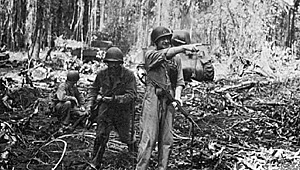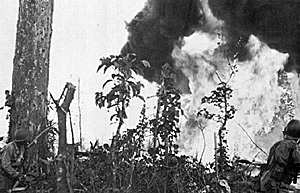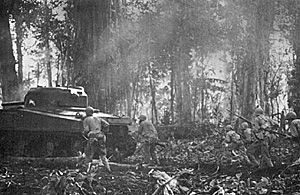The sector of the 37th Division's 129th Infantry, where Colonel Magata delivered his attack, was generally flat and low. In contrast with the Iwasa Unit, which assaulted up very steep slopes, Magata's soldiers possessed easy routes of approach along Numa Numa Trail and various streams. The 129th, in the center of the 37th Division's line, held about 3,900 yards of curving front from a point slightly east of the Numa Numa Trail west and southwest to the right flank of the 148th Infantry. Several small streams, all tributaries of the Koromokina River, flowed through the area in a generally southerly direction. Taylor Creek cut through the 129th's lines less than 1,000 yards west of Numa Numa Trail. Cox Creek entered the line about 750 yards southwest of Taylor Creek's penetration. The Logging Trail, cut and used extensively by XIV Corps engineers in the relatively peaceful days before March, entered the main perimeter just west of Taylor Creek.
The 129th Infantry, commanded by Col. John D. Frederick, held its front with two battalions in line. The 2d Battalion, on the right, faced north, its left (west) flank joined to the right of the 3d Battalion between Cox Creek and another branch of the Koromokina River.
In general, the 129th's positions were stronger than the 145th's, since the terrain permitted grazing fire except in the numerous ravines and gullies that were scattered throughout the area. Earth-and-log-pillboxes, mutually supporting and arranged in depth, formed the backbone of the main line of resistance, which was wired in behind single barbed wire and double-apron barbed wire fences. Antipersonnel mines had been laid in front of the wire. The entire front was covered by interlocking bands of machine gun fire. Additional rows of double-apron barbed wire extended diagonally from the main line of resistance to channel Japanese attacks into the machine gun fire lanes.
In addition to division artillery, mortars, and the 75-mm. pack howitzers of the 129th's Cannon Company, the front was supported by 37-mm. antitank guns (firing canister) and 40- mm. antiaircraft guns.
The 2d Battalion, under Lt. Col. Preston J. Hundley, had in line three rifle companies, F, G, and E from left to right. Cox Creek lay in F Company's sector, the Logging Trail and Taylor Creek in G's, and the Numa Numa Trail in E's.
During the early days of the 17th Army's attack the 129th Infantry received mortar and artillery fire, engaged in fire fights and patrol clashes' and strengthened its positions, but was not heavily engaged in battle. But on i i March Colonel Magata moved forward from his assembly area behind Mount Nampei to begin the attack that was designed to pierce the 129th Infantry and capture the Piva airfields not far away. Outposts and patrols reported increasing numbers of Japanese troops in front of the 129th, and the artillery fired on them off and on all day. When an antipersonnel mine in front of E Company was exploded about 1600, Colonel Frederick ordered in the outposts.
Shortly afterward Japanese troops were reported advancing down the Logging Trail toward the perimeter. Starting at 1800, when all outposts and patrols had come in, division artillery and mortars laid a ten-minute concentration to the front of Colonel Hundley's battalion. A patrol from G Company went out to examine the impact area, now cleared of underbrush and foliage, but came under Japanese fire and returned to the perimeter to report that it had located no less than fourteen enemy machine guns.
Firefight
In the gathering dusk Magata's troops, the 1st Battalion, 45th Infantry, on the left (east) and the 3d Battalion on the right-opened up on the 2d Battalion, 129th, with machine guns and rifles.
The Americans replied with rifles, mortars, machine guns, and a 40-mm. antiaircraft gun, which along with a .50-caliber machine gun put searching fire up the Logging Trail. Machine guns in the frontline pillboxes abstained from firing so as not to reveal their locations to the enemy. This fire fight continued until 1920, then died down to flare up sporadically throughout the night.
 MAJ. GEN. ROBERT S. BEIGHTLER, Commanding General, 37th Division, directing tank-infantry attack, 16 March 1944
MAJ. GEN. ROBERT S. BEIGHTLER, Commanding General, 37th Division, directing tank-infantry attack, 16 March 1944
General Beightler, at 2100, ordered his regimental commanders to keep their troops alert, for documents captured that day (apparently on Hill 700) indicated that the Japanese planned to attack in strength the next day. At the same time, as Japanese soldiers began working their way through the American wire, C Company, 82d Chemical Battalion, was attached to the 129th Infantry, and at 0420 the next morning its 2d Platoon moved its 4.2-inch mortars into position behind the Antitank Company, 129th, which was supporting the rifle companies.
By dawn of 12 March, though the Japanese had made earnest efforts to get through the lines, they found they had been held for very small gains. As the coming of daylight clarified the situation, the 2d Battalion, 129th, found that the Japanese had succeeded in cutting through G Company's wire and effecting two minor penetrations. In the 2d Platoon sector, where Taylor Creek and the Logging Trail entered the perimeter, the Japanese had captured two pillboxes (one an alternate, unoccupied position), and to the right (east) they had seized five pillboxes.
The Japanese tried to exploit their penetrations and break out to the south but were held back by American artillery, mortar, machine gun, and rifle fire. Then the 129th prepared to counterattack and restore the line. Colonel Frederick ordered C Company out of regimental reserve and forward to support G Company at 0723. By o81o, when C Company moved into position behind the 2d Platoon of G Company, one platoon of the Antitank Company had attacked the western penetration and retaken one pillbox. During the rest of the morning another Antitank Company platoon moved in behind E Company; 81-mm. mortars of D Company, 129th, took up positions to support the 2d Battalion; and B Company moved forward behind C.
 JAPANESE PILLBOX ON FIRE
JAPANESE PILLBOX ON FIRE
At 1255, after a mortar concentration, three rifle platoons (two from C and one from G), plus two flame throwers, attacked the western penetration and by 1405 had retaken the second pillbox. The Japanese retaliated with a counterattack that was promptly repulsed. By the end of the day the Japanese still held the five pillboxes, which the Americans had not attacked, in the 3d Platoon's sector. Two Americans had been killed, twenty-two wounded in the day's action as compared with one killed and six wounded the day before.
Artillery Attack
American artillery and mortars shelled the enemy during the night. Searchlights tried to illuminate him with direct beams, but failed as he took refuge in the ravines and draws. The searchlights then achieved more success by raising their beams so that they were reflected from the clouds.
The 1st and 3d Battalions of the 45th Infantry struck again at G Company about 0400 on 13 March and gained one more pillbox before they were stopped. To eliminate this penetration, Colonel Frederick requested tanks. (His request for tanks on 12 March had been turned down.)
Corps headquarters, at 0815, released the 1st Platoon of C Company, 754th Tank Battalion, to the 129th. General Griswold released the tanks with the express proviso that they could not be used as stationary defenses, but must be employed in an attack to recapture the lost pillboxes. At 0812 General Beightler ordered the 129th not to deliver any piecemeal infantry attacks but to wait for the tanks and organize a co-ordinated tankinfantry assault. He issued this order just fifteen minutes after C Company, 129th, made a local counterattack which regained one pillbox.
Four tanks and elements of B, C, and G Companies attacked at 1000 after a ten-minute artillery preparation. Although the ground was generally level, the tanks had difficulty in bringing their guns to bear because the Japanese were down in ravines with steep slopes. After two pillboxes had fallen, the tanks withdrew. The attack was renewed at 1315. After another hour the tanks had almost exhausted their fuel and ammunition, and the attack was suspended while the 2d Platoon, C Company, 754th Tank Battalion, came up to replace them. (During the afternoon XIV Corps headquarters assigned one battalion of the 131st Engineer Regiment to buttress the 1st Battalion, 24th Infantry, on the 129th regimental reserve line. A Company of the i3ist had been assigned the day before.)
The new tanks and the same infantry units attacked at 1730. This time the tanks and infantry managed to demolish all the Japanese- hela pillboxes. By 1930, at a cost of eighteen wounded, the original line was almost restored. Colonel Magata withdrew his battalions to rest, reorganize, reconnoiter, and make ready for another attack.
On the l4th, a day that was quiet except for small arms fire and occasional shelling, the 2d Battalion repaired its positions, strung new wire, planted mines in the ravines that provided covered routes of approach, and fired its mortars. Patrols went out and reported the presence of strong bodies of the enemy not far from the perimeter. Thus the Americans were sure that the Japanese withdrawal was only temporary.
Temporary it was, for at 0400 on 15 March the 1st and 3d Battalions of the 45th Infantry and the 2d Battalion, 81st Infantry, renewed the assault. They again achieved a small local success in the Cox Creek sector held by the 2d Platoon of F Company. By dawn they had seized one pillbox and penetrated to a depth of about one hundred yards. F Company, supported by one platoon of C Company and aided by a 36-plane air strike in front of the battalion line, counterattacked with flame throwers and bazookas to recapture the pillbox by 1153.
But the enemy, still holding a salient in the line, was digging positions in the roots of banyan trees and appeared to be pushing in reinforcements and more weapons.
General Craig, arriving in the sector to observe and inform General Beightler, as he had on Hill 700, asked for tanks. General Griswold sent a platoon. A tank-infantry attack, delivered at 1500 with artillery and mortar support, made small gains. A second, at 1635, killed or drove off all the enemy at a cost of seven killed, fifty- six wounded, and one tank damaged. One hundred and ninety Japanese corpses lay within the American lines, and four enemy soldiers were captured. The Japanese suspended their assaults on 16 March but renewed them on the l7th and effected a small penetration in F Company's sector which tanks and infantry promptly eliminated.
This was the last attack for several days, for the Japanese overhauled their plans. They had decided to abandon the attacks on Hills 260 and 700 in favor of a massed attack by the depleted regiments of the 17th Army against the 129th Infantry. While the survivors of the Muda and Iwasa Units, except for the screening forces on Hill 260, moved through the jungles to Magata's position, the front lines remained static. Artillery and mortar fire, patrol skirmishes, and fire fights continued, especially in the sector of the 2d Battalion, 129th Infantry. By 23 March the 13th and 23d Regiments had joined Magata and the attack was ready. But captured documents and reconnaissance enabled the Americans to divine Japanese intentions, so that in late afternoon of the 23d Beightler warned his troops to expect a general attack at dusk.
Last Attack
After dark the Japanese shelled the American positions. As before, sporadic fire fights went on all night and, concealed by the darkness, nearly all Hyakutake's remaining units attacked through the ravines. ( In 1949 Kanda asserted that on his recommendation Hyakutake had called off this attack, but the validity of his assertion is belied by American experience and by contemporary Japanese documents.)
The 37th Division artillery and the various mortars promptly opened fire and largely broke up the Japanese assault before it got started. But the enemy succeeded in again piercing the 1st Platoon of F Company in the Cox Creek area, this time a little to the west of the earlier penetration. (Also defending this sector, in supporting positions, were platoons of B and C Companies.)
About one hundred Japanese soldiers captured four pillboxes and pushed to a low ridge about twentyfive yards from the battalion command post. When dawn broke a fire fight was raging throughout the entire area as the Japanese unsuccessfully attempted to enlarge their holdings.
The American commanders responded promptly. Two platoons of the Antitank Company and one platoon of K Company, 129th, assembled near the 2d Battalion command post, and General Beightler dispatched two companies of the 148th Infantry to positions behind Colonel Hundley's battalion. The Antitank and K Company platoons, plus the 3d Platoon, A Company, 754th Tank Battalion, attacked northwest from the command post at 0725 and within twenty minutes had gained possession of the ridge. At 0930 the attackers reorganized and drove in again, supported this time by 37th Division artillery, three battalions of the Americal Division artillery, the 129th Infantry Cannon Company, and twenty-four 4.2-inch mortars, which fired into the ravines. (The fire was repeated twice during the afternoon.)
 TANK-INFANTRY ATTACK, 16 March 1944. Men following the medium M4 tank are from the 129th Infantry.
TANK-INFANTRY ATTACK, 16 March 1944. Men following the medium M4 tank are from the 129th Infantry.
The Americans burned, dug, and blasted the Japanese out of their ravines, trenches, foxholes, and pillboxes while the seven artillery battalions, their fire directed by General Kreber and augmented by the heavy mortars, shelled the concentrated enemy troops in front of the American lines. By 14oo General Griswold had dispatched more reserves to the area but they were not needed. The Japanese were dead or dispersed, the line restored. Hyakutake's counteroffensive was over.
His troops withdrew from the 129th's front pursued by the Fijians and two American battalions from the corps reserve, and on the same day he told Imamura that further attacks would be fruitless. Imamura left the next move to Hyakutake but ordered him to resort to guerrilla warfare and raise as much of his own food as possible. Hyakutake, though not abandoning his desire to counterattack, elected to withdraw to the posts whence he had come. The 6th Cavalry and the 2d Battalion, 4th South Seas Garrison Unit, came north to cover the retreat which began on 27 March. South Knob of Hill 260 was evacuated; the Americans reoccupied it on 28 March. The withdrawal was an orderly affair, although wounded men and heavy equipment were abandoned along the way.
In the attack the Japanese had lost over 5,000 men killed, more than 3,000 wounded. The XIV Corps lost 263 dead in its successful defense. (Griswold, Bougainville, p. 139; 8th Area Army Operations, Japanese Monogr No. 110 (OCMH), p. 111. By 29 April twenty-eight 75- mm., one 105-mm., and four 150-mm. field pieces had fallen into Allied hands.)
The 17th Army, in spite of its serious losses, was still an effective fighting force; late March and early April saw several sharp fights when the XIV Corps fanned out to pursue the enemy and enlarge the perimeter. (This was done to gain commanding ground, to establish trail blocks, and, at the behest of the War Department, to give combat experience to the 1st Battalion, 24th infantry, and the 25th Regimental Combat Team of the 93d Division, which arrived in late March.)
So ended the last Japanese offensive effort in the Solomons. Had it succeeded, it would have seriously affected the course of the war in the Solomons by requiring the commitment of more men, ships, and planes to recapture Empress Augusta Bay. But it is unlikely that it would have had any real effect on the final outcome of the war.
More Bougainville Counterattack
- Preparations
Japanese Plan of Attack
Battle of Hill 700
Battle of Hill 260
Action by the Creeks
Jumbo Map: Japanese Counterattack on Bougainville (very slow: 211K)
Back to Table of Contents -- Operation Cartwheel
Back to World War Two: US Army List of Issues
Back to MagWeb Magazine List
© Copyright 2002 by Coalition Web, Inc.
This article appears in MagWeb (Magazine Web) on the Internet World Wide Web.
Other military history articles and gaming articles are available at http://www.magweb.com